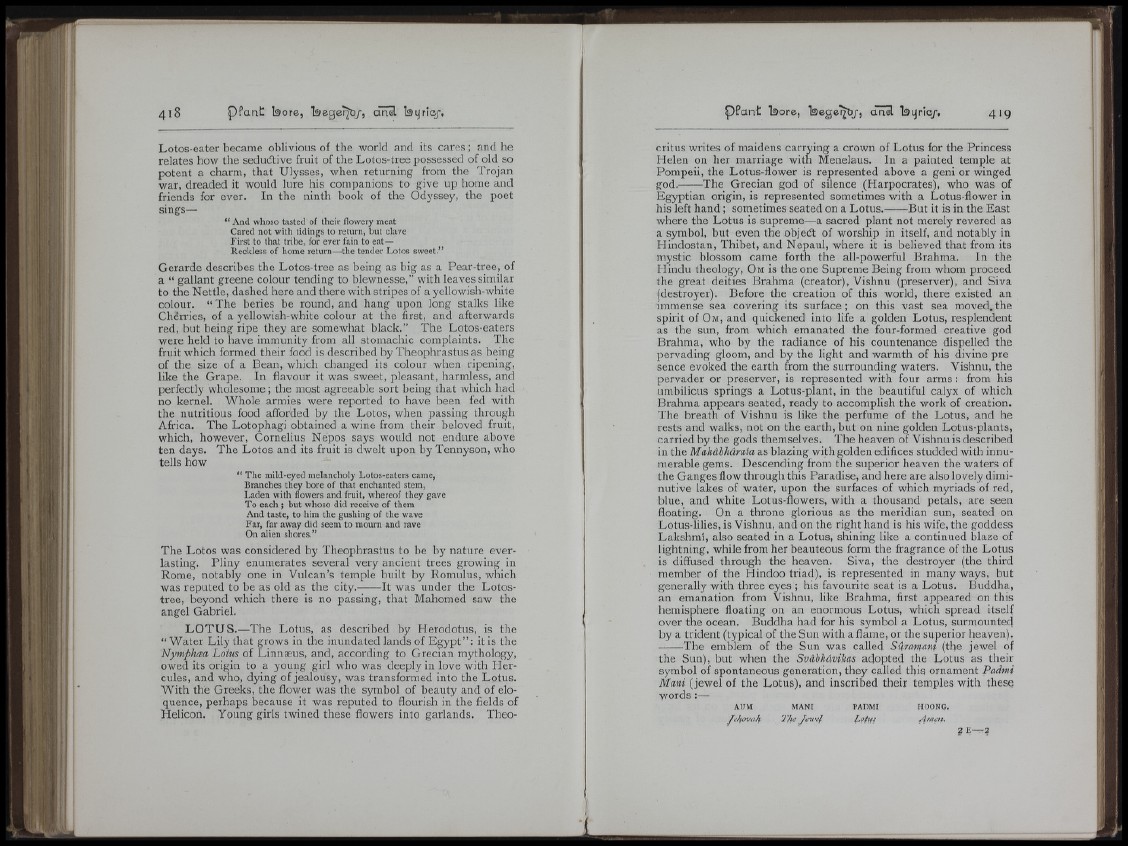
i f
Lotos-eater became oblivious of tlic world and its cares ; and lie
relates how the seducffive fruit of the Lotos-tree possessed of old so
potent a cliarm, that Ulysses, wlien returning from the Trojan
war, dreaded it would lure his companions to give up home and
friends for ever. In the ninth book of the Odyssey, the poet
sings—
“ And whoso tasted of their flowery meat
Cared not with tidings to return, but clave
First to that tribe, for ever fain to eat—
Reckless of home return—tlie tender Lotos sweet.”
Gerarde describes the Lotos-tree as being as big as a Pear-tree, of
a “ gallant greene colour tending to blewnesse,” with leaves similar
to the Nettle, dashed here and tliere with stripes of a yellowish-white
colour. “ The beries be round, and liang upon long stalks like
Cherries, of a yellowish-white colour at tlie first, and afterwards
red, blit being ripe they are somewhat black.” The Lotos-eaters
were held to have immunity from all stomachic complaints. The
fruit which formed their food is described by Theophrastus as being
of the size of a Bean, which changed its colour when ripening,
like the Grape. In flavour it was sweet, pleasant, harmless, and
perfectly wholesome; the most agreeable sort being tliat which had
110 kernel. Whole armies were reported to have been fed with
the nutritious food afforded by the Lotos, when passing tlirongh
Africa. The Lotophagi obtained a wine from their beloved fruit,
which, however, Cornelius Nepos says would not endure above
ten days. The Lotos and its fruit is dwelt upon by Tennyson, who
tells how
“ The mild-eyed melancholy Lotos-eaters came,
Branches they bore of that enchanted stem,
Laden with flowers and fruit, whereof they gave
To each ; but whoso did receive of them
And taste, to him the gushing of the wave
Far, far away did seem to mourn and rave
On alien shores.”
The Lotos was considered by Theophrastus to be by nature everlasting.
Pliny enumerates several very ancient trees growing in
Rome, notably one in Vulcan’s temple built by Romulus, wliich
was reputed to be as old as the city, It was under the Lotostree,
beyond which there is no passing, that Mahomed saw the
angel Gabriel.
L O T U S .—The Lotus, as described by Herodotus, is the
“ Water L ily that grows in the inundated lands of Egypt ” : it is the
Nymphaa Lotus of Linnaeus, and, according to Grecian mythology,
owed its origin to a young girl who was deeply in love with Hercules,
and who, dying of jealousy, was transformed into the Lotus.
With the Greeks, the flower was the symbol of beauty and of eloquence,
perhaps because it was reputed to flourish in the fields of
Plelicon. Young girls twined these flowers into garlands. Theo419
critus writes of maidens carrying a crown of Lotus for the Princess
Helen on her marriage with Menelaus. In a painted temple at
Pompeii, the Lotus-flower is represented above a geni or winged
god. The Grecian god of silence (Harpocrates), who was of
Egyptian origin, is represented sometimes with a Lotus-flower in
his left hand ; sometimes seated on a Lotus, But it is in the East
wliere the Lotus is supreme—a sacred plant not merely revered as
a symbol, but even the objecft of worship in itself, and notably in
Plindostan, Thibet, and Nepaul, where it is believed that from its
mystic blossom came forth the all-powerful Brahma. In the
Hindu theology, Om is the one Supreme Being from whom proceed
the great deities Brahma (creator), Vishnu (preserver), and Siva
(destroyer). Before the creation of this world, there existed an
immense sea covering its surface ; on this vast sea moved, the
spirit of O m , and quickened into life a golden Lotus, resplendent
as the sun, from which emanated the four-formed creative god
Brahma, who by the radiance of his countenance dispelled the
pervading gloom, and by the light and warmth of his divine pre
sence evoked the earth from the surrounding waters. Vishnu, the
pervader or preserver, is represented with four arms: from his
umbilicus springs a Lotus-plant, in the beautiful calyx of which
Brahma appears seated, ready to accomplish the work of creation.
The breath of Vishnu is like the perfume of the Lotus, and he
rests and walks, not on the earth, but on nine golden Lotus-plants,
carried by the gods themselves. The heaven of Vishnu is described
in the Mahdbhdrata as blazing with golden edifices studded with innumerable
gems. Descending from the superior heaven the waters of
the Ganges flow through this Paradise, and here are also lovely diminutive
lakes of water, upon the surfaces of which myriads of red,
blue, and white Lotus-flowers, with a thousand petals, are seen
floating. On a throne glorious as the meridian sun, seated on
Lotus-lilies, is Vishnu, and on the right hand is his wife, the goddess
Lakshmi, also seated in a Lotus, shining like a continued blaze of
lightning, while from her beauteous form the fragrance of the Lotus
is diffused through the heaven. Siva, the destroyer (the third
member of the Hindoo triad), is represented in many ways, but
generally with three eyes ; his favourite seat is a Lotus. Buddha,
an emanation from Vishnu, like Brahma, first appeared on this
hemisphere floating on an enormous Lotus, which spread itself
over the ocean. Buddha had for his symbol a Lotus, surmounted
by a trident (typical of the Sun with a flame, or the superior heaven).
The emblem of the Sun was called Sdramani (the jewel of
the Sun), but when the Svdbhdvihas adopted the Lotus as their
symbol of spontaneous generation, they called tips ornament Padnd
Mani (jewel of the Lotus), and inscribed theif temples with these
words :—
A U M MANI
Jehovah The Jeioel
PADMI
lotus
HOONQ,
A mai.
i!i|
m
2 E